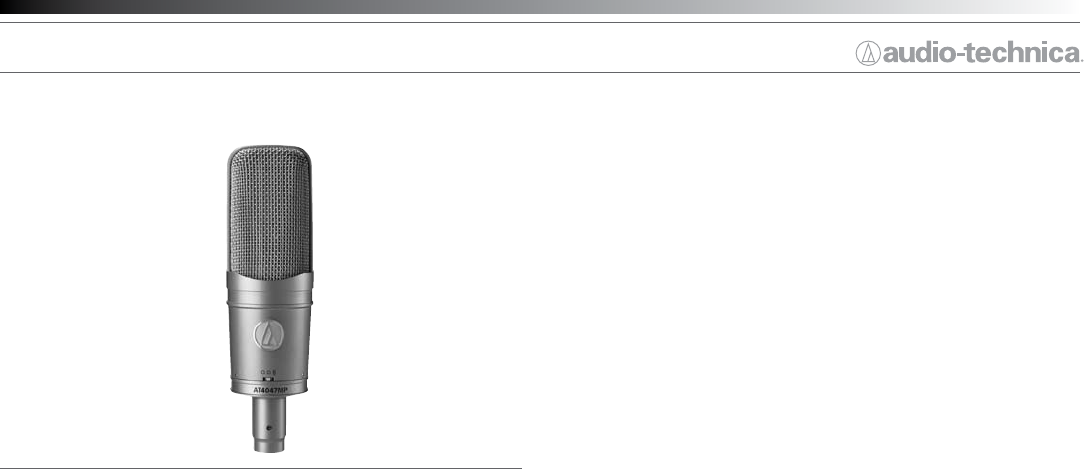
40 series microphones
AT4047MP
Multi-Pattern Condenser Side-Address Microphone
Features
• Speciallyengineeredtomeetthemostcriticalacoustic
requirementsofprofessionalrecording,broadcastandsound
reinforcement
• Threeswitchablepolarpatterns:omnidirectional,cardioid,
gure-of-eight
• Transformer-coupledoutputandspeciallytunedelementprovide
soniccharacteristicsreminiscentofearlyF.E.T.studiomicrophone
designs
• Exceptionallylowself-noise,widedynamicrangeandhigh
SPLcapability
• Dual-diaphragmcapsuledesignmaintainsprecisepolarpattern
denitionacrossthefullfrequencyrangeofthemicrophone
• Precision-machined,nickel-platedbrass,acousticelementbafe
providesenhancedelementstabilityandoptimalsensitivity
• Vintagesilver-mattenishonmicrophoneandshockmount
• Openacousticalenvironmentofthesymmetricalhousing
assemblyminimizesunwantedinternalreections
• Customshockmountprovidessuperiorisolation
• Integral80Hzhigh-passlterswitchand10dBpadswitch
• State-of-the-artdesignandmanufacturingtechniquesensure
compliancewithA-T’sstringentconsistencyandreliabilitystandards
Description
The AT4047MP is a large-diaphragm side-address externally polarized
(DC bias) condenser microphone with three switchable polar patterns:
omnidirectional, cardioid, and gure-of-eight. It is designed to meet the
most critical acoustic requirements of professional recording, broadcast
and sound reinforcement.
The microphone requires 48V phantom power for operation.
The omnidirectional polar pattern is sensitive to sound coming from
all directions. Select the omni pattern to pick up several voices or
instruments on the same microphone, to diminish proximity effect, and
to preserve the location’s ambient sound.
The cardioid polar pattern is more sensitive to sound originating directly
in front of the element, making it useful in controlling feedback, reducing
pickup of unwanted sounds and providing isolation between performers.
The gure-of-eight polar pattern is more sensitive to sound originating in
the front and back of the microphone, rejecting sounds from the sides. It
is often used in conjunction with advanced stereo miking techniques.
The output of the microphone is a 3-pin XLRM-type connector.
The microphone is equipped with a switchable 10 dB pad and a switch
that permits choice of at response or low-frequency roll-off (via integral
80 Hz high-pass lter).
The microphone is enclosed in a rugged housing. The included AT8449/SV
shock mount provides superior isolation and permits mounting on any
microphone stand with
5
/
8
"-27 threads. A dust cover and a protective
carrying case are also included.
Operation & Maintenance
The AT4047MP requires 48V phantom power for operation.
Output is low impedance (Lo-Z) balanced. The signal appears across Pins
2 and 3; Pin 1 is ground (shield). Output phase is “Pin 2 hot” – positive
acoustic pressure produces positive voltage at Pin 2.
To avoid phase cancellation and poor sound, all mic cables must be wired
consistently: Pin 1-to-Pin 1, etc.
A raised Audio-Technica emblem and the pattern-selection switch are on
the front of the microphone. Position this side of the microphone toward
the sound source.
The pattern-selection switch provides user-selection of omnidirectional,
cardioid, and gure-of-eight polar patterns. To select the omnidirectional
polar pattern, slide the switch to the circular polar pattern image. To select
the cardioid polar pattern, slide the switch to the heart-shaped polar pattern
image. To select the gure-of-eight pattern, slide the switch to the gure-
eight shaped polar pattern image.
An integral 80 Hz high-pass lter provides easy switching from a at
frequency response to a low-end roll-off. The roll-off position reduces the
microphone’s sensitivity to popping in close vocal use. It also reduces
the pickup of low-frequency ambient noise (such as trafc, air-handling
systems, etc.), room reverberation and mechanically coupled vibrations. To
engage the high-pass lter, slide the switch toward the “bent” line.
The microphone is also equipped with a switchable 10 dB pad that lowers
the microphone’s sensitivity, thus providing higher SPL capability for
exible use with a wide range of users and system congurations. To
engage the 10 dB pad, slide the switch toward the -10 position.
In use, secure the cable to the mic stand or boom, leaving a slack loop
at the mic. This will ensure the most effective shock isolation and reduce
the possibility of accidentally pulling the microphone out of its mount.
Avoid leaving the microphone in the open sun or in areas where
temperatures exceed 110° F (43° C) for extended periods. Extremely high
humidity should also be avoided.
Architect’s and Engineer’s Specications
The microphone shall be a large-diaphragm side-address externally
polarized (DC bias) condenser with user-switchable omnidirectional,
cardioid, and gure-of-eight polar patterns and a frequency response of
20 Hz to 18,000 Hz. The microphone shall operate from an external 48V
DC phantom power source. It shall be capable of handling sound input
levels up to 155 dB (165 dB with 10 dB pad) with a dynamic range of 141
dB. Nominal open-circuit output voltage shall be 7.9 mV at 1V, 1 Pascal.
Output shall be low impedance balanced (100 ohms).
The output of the microphone shall be a 3-pin XLRM-type connector.
The microphone shall be equipped with a switchable 10 dB pad, a switch
that permits choice of at response or 80 Hz low-frequency roll-off and a
polar pattern selection switch.
The microphone shall be 188.0 mm (7.40") long and have a maximum
body diameter of 53.4 mm (2.10"). Weight shall be 524 g (18.5 oz). The
